This was published 8 months ago
Rich man, poor man, gangland, parmesan: Melbourne’s constantly shifting suburb
The image of Carlton and Lygon Street as a locale of ne’r-do-wells and rogues on the make, dipping in and out of wine bars and Italian eateries, always finds its way into conversation about the history of the inner-northern suburb. But a few generations on the story of Carlton has changed.
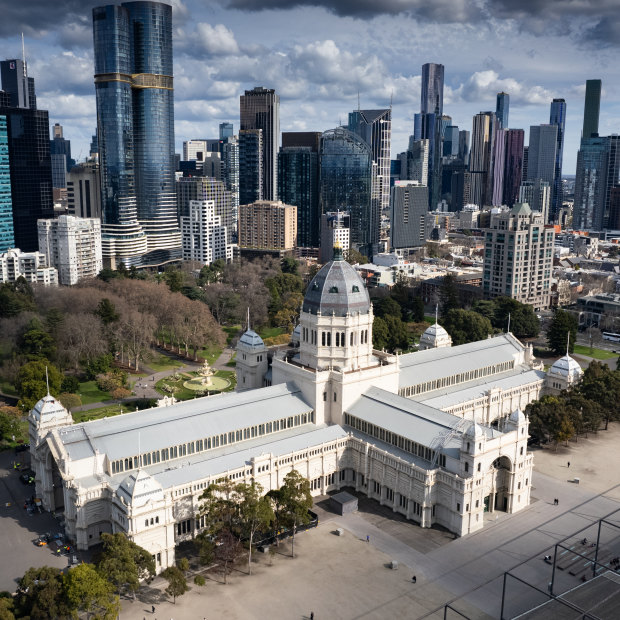
Carlton and the Royal Exhibition Building.Credit: Jason South
Off the balcony at Johnny’s Green Room in Carlton the city’s skyline looks so close and glistens with such intensity that it could be within arm’s reach. It’s a clear and bitterly cold Saturday night but Johnny’s, on the top floor corner of Lygon Street and Faraday Street, is heaving.
There’s this great legend about Johnny’s.
In the early 1970s, underworld kingpin Alphonse Gangitano, known by his epithet “the Black Prince of Lygon Street”, got his first sawn-off shotgun from Mark “Chopper” Read in some dark corner of Johnny’s former location on Faraday Street.
At the time Johnny’s was a confluence of sleaze, subterfuge and radicalism: students, artists, bohemians, crooks and dopers shot pool inside the heady 24-hour speakeasy where you could score marijuana or pasta at any hour of the night.
A fledgling delinquent, Gangitano was just 16 when he armed himself courtesy of Chopper, who would later become a fierce underworld rival. But if the Black Prince or Chopper were stalking Lygon Street these days they might be forgiven for not recognising the joint.
“We thought, well, we’ve heard so many stories about Johnny’s,” says owner Luca Sbardella, speaking affectionately of the old Johnny’s, “it truly was one of the most infamous venues that I’ve ever heard of in Melbourne.”
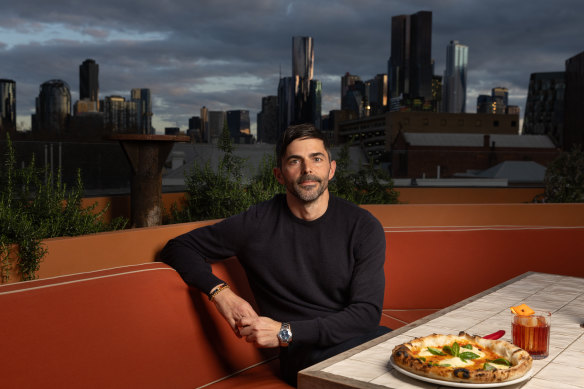
Owner Luca Sbardella at Johnny’s Green Room.Credit: Jason South
This image of Carlton and Lygon Street, as a locale of ne’r-do-wells and rogues on the make, always finds its way into conversations about the storied history of the inner-northern suburb.
Hosting the Exhibition Building, Trades Hall, the La Mama Theatre, Cinema Nova, the massive public housing towers and Readings, Carlton is home to institutions that sit at the centre of Melbourne’s cultural life and are now passed between generations.
But a few generations have seen the story of Carlton change.
Johnny’s now sits atop upmarket restaurant King & Godfree, also owned by Sbardella. Its sleek wooden interiors house well-heeled and well-dressed young patrons who sip cocktails underneath red and white Campari-branded parasols unfurled indoors.
On Saturday The Age didn’t spot any shady figures slinging dope or bikies knocking billiards around. Instead, young men watch YouTube, a woman issues strict commands to chilly friends posing for a group photo and a security guard in a white blazer lingers out front.
“I’m really proud of kind of what my cousin Jamie and I have done to kind of continue the legacy of Johnny’s because it had such a big reputation … we’re a little cheeky there too,” Sbardella says.
“So it kind of still fits in line with what Johnny’s really was.”
The many phases of Carlton
Before colonisation, there were multiple Woiwurrung-speaking clans who neighboured each other in the area that would become known as Carlton. Wurundjeri is the combination of the Woiwurrung words “wurun” meaning the Manna Gum (Eucalyptus) and “djeri”, the grub found in or near the tree.
Before their forcible displacement, Wurundjeri were self-sufficient, and would not take more than the land could spare. The Wurundjeri-willam clan’s home was on the northern side of the Yarra River, from its junction with the Maribyrnong River and east as far as Kew.
The clan was moved to the Coranderrk station, near Healesville, along with others from the Kulin nation. Their resilience meant they survived colonisation and maintain a connection to land and culture.
Carlton Community History Group president Jeff Atkinson does tours for people looking to learn about their patch. Parts of Carlton were settled shortly after Melbourne – around 1835 – before its population swelled with gold prospectors.
After they’d had their shot digging throughout Victoria, down and out, they’d find themselves in the slums of Carlton, living in a tent until they could travel back home.
It was also filled with Yiddish-speaking migrants from Eastern Europe fleeing Russian antisemitism in the 1880s and 1890s who found their home in Carlton. It became the centre of Jewish residence north of the Yarra River.
After a generation of prosperity, when property developers built their homes in Carlton, it was hit by the financial crisis in the 1890s. It was a catastrophe that saw real GDP fall 17 per cent over 1892 and 1893 and plunged Carlton into desperate poverty it wouldn’t shake for 70 years.
“Big houses got sold, turned into boarding houses and the place sort of went down,” Atkinson says.
Slums emerged. It became a forgotten corner of Melbourne, for the poor and down-and-outs. The slums were shacks and old cottages without sewerage and often lacked running water.
Disease, alcoholism, high child mortality and crime flourished in the meaner streets. The infamous Carlton Larrikin push, a youth gang that would prey upon residents and traders, scared people.
As did Joseph “Squizzy” Taylor, a crime lord who ran the northern suburbs with an iron fist and met his end in a gun battle in the bedroom of his rival’s mother’s house. Gut shot, he hobbled to St Vincent’s Hospital before succumbing to his wound.
Social reformer Frederick Oswald Barnett, motivated by the Christian socialism of the Methodist Church and seeing the poverty, captured a series of groundbreaking photos of the slums of the area, showing the scale and desperation of the encampments, and advocating that it was society’s responsibility to improve the area. It made the government take notice.
As it was for the Eastern European Jewish community, Carlton became the first port of call for Italians after the Second World War.
Europe decimated, many Italian migrants settled in the northern suburbs and set about establishing the suburb as a home away from home in the ’60s and ’70s.
“It had this sort of reputation as a slum but it was gaining a reputation as being a very interesting and cosmopolitan place,” Atkinson says.
Provocative and cosmopolitan
That cosmopolitanism was translated through two communities, the Italian diaspora and student radicals.
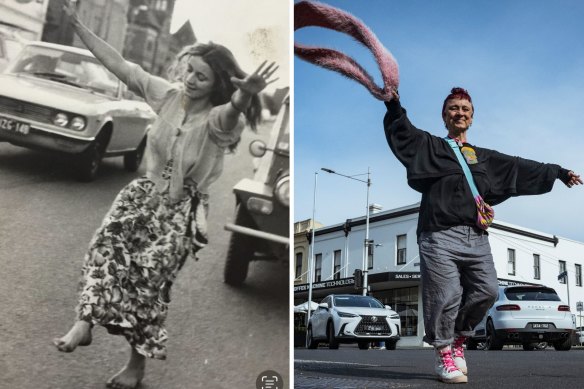
Polly Courtin dances at the intersection of Lygon and Faraday Streets in the early ’70s (left) and in August 2024 (right).
Polly Courtin has been coming to Carlton since she was 16. At the time she was engaged to the youngest boy in a prosperous family and would occasionally work in their shop. She opens her phone and fishes out a photo of her in her early 20s, shoeless, playing a gig in the middle of the road at the intersection of Lygon and Faraday streets, just outside modern-day King & Godfree.
“I was a barefoot hippy dancing around in the road,” she says.
As she walks from the counter at Brunetti’s to show The Age the spot where she danced around in the early ’70s, she explains she returns to Carlton for some indefatigable quality that renews her before she retreats to her solitary studio for a day’s painting.
“It’s like a Rome train station,” she says, “I’ve travelled a lot because I paint in different countries and exhibit, and it’s that transience, which I really like as a painter.”
The transient student population has called Carlton home for multiple generations. Its proximity to the University of Melbourne meant the burgeoning Italian diaspora served espresso to students in coffee shops along Lygon Street.
Down the road at Heart Attack and Vine, Madeleine Sergeant and Maya Honey-Holmes share coffee and a book on a frosty morning. As they detail their affinity for Carlton – the mornings they’ve shared, dinners with parents, hours lost browsing Readings and last-minute movies – Sergeant has a moment of clarity.
“This conversation is really making me freak out about all the things I’ve done on Lygon Street,” she says.
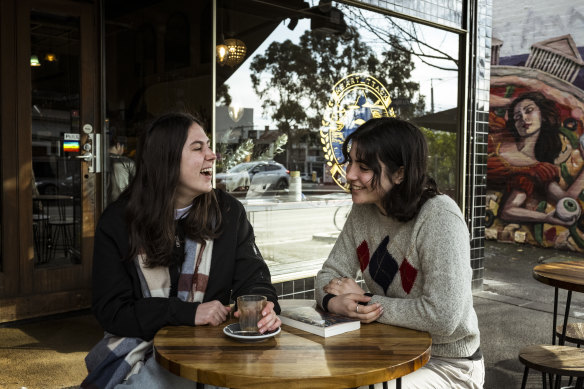
Friends Madeline Sergeant (left) and Maya Honey-Holmes catch up.Credit: Photograph by Chris Hopkins
It’s a theme that arose constantly in conversation this week, so many Melburnians have an affection for and relationship with the suburb, especially students and the Italian community.
It was this early marriage, between students, artists and Italian migrants, which allowed the communities to grow in tandem and flourish with the other big Carlton institution: football.
‘Kinship’ and the mighty Blues
When Matteo Vasarelli arrived from Italy, Carlton’s home ground was literally a drop punt from his front door. He gravitated to the club after watching a few finals games in ’56 and ’57 and has never left.
“It became a part of my life,” he says.
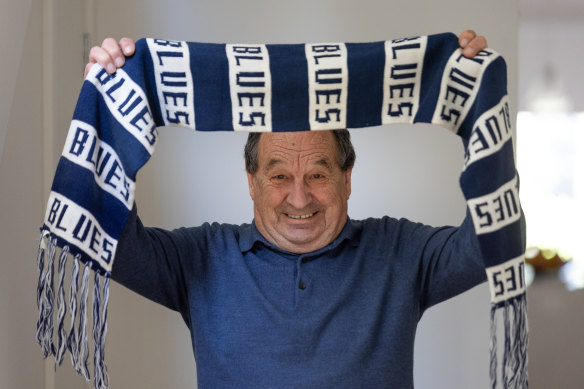
Carlton fan Matteo Vasarelli.Credit: Jason South
Unlike many modern AFL clubs, Carlton Football Cub’s rise mirrors the rise of Lygon Street in the ’60s and ’70s, and provided a language for new Italian migrants to merge their experience with Australia’s.
“The Carlton Football Club had a big role to play,” says Marco Donnini, sipping espresso leaning against the bar of his family’s Lygon Street restaurant Donnini’s, “because it won premierships in 1979, 1981 and 1982. Those three premierships in four years allowed people to be able to also celebrate their association or affiliation with Carlton.”
He says that his family’s restaurants (Donnini’s and the iconic University Cafe) both benefited from a Carlton win when fans would flood Lygon Street to celebrate and revel in the game.
It was also a shared language along with the food the Italians were showing Australia, which allowed the assimilation to accelerate and cement the community as a core part of Melbourne, he says.
“I believe that Carlton, in particular, gave that, I guess, purpose. We wanted to be able to start a new life.”
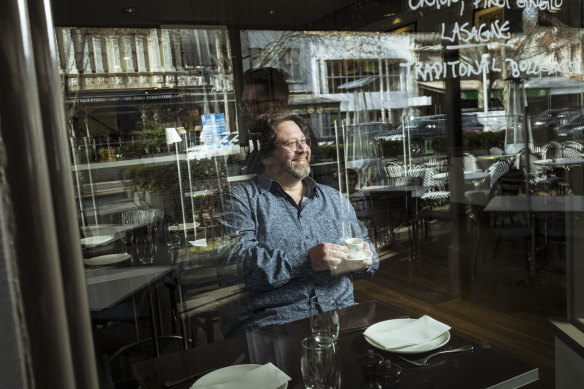
Marco Donnini at his Lygon Street restaurant Donnini’s.Credit: Photograph by Chris Hopkins
Club historian Tony De Bolfo points out the club’s robust links with its local community have endured through three centuries, from as far back as 1865 when the pioneering forefathers, most of them English or Irish-born, convened the club’s first annual general meeting at Lygon Street’s University Hotel.
“Indeed, no club could genuinely lay claim to a greater kinship with its local trading strip than Carlton with Lygon Street,” he says.
“By their deeds, new Australians identified – and in Carlton they discovered a community connection and a sense of belonging.”
Carlton’s underworld
Walk out of Donnini’s and head north to the corner of Lygon and Drummond streets, take a right, stroll for a minute or two and you’ll land on the doorstep of East Imperial, a Chinese restaurant.
Sbardella, the owner of Johnny’s, can remember driving past and seeing people running out of the venue after Carlton Crew veteran Dominic “Mick” Gatto killed hitman Andrew “Benji” Veniamin in a struggle in the eatery’s rear.
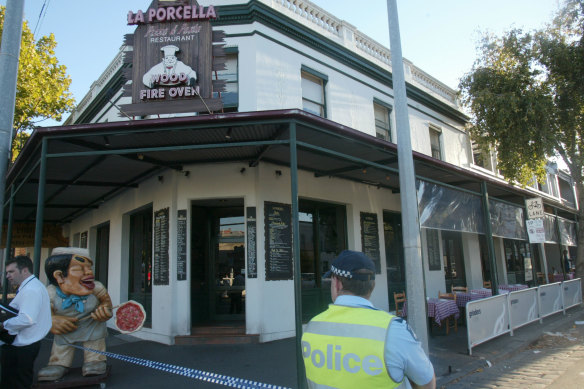
La Porcella in 2004 after Andrew Veniamin was shot dead in the back of the eatery.Credit: Michael Clayton-Jones
Back then it was called La Porcella. Gatto, ever the gentleman, apologised to owner Michael Choucair from his cell at Port Phillip Prison. He was acquitted of Veniamin’s killing on self-defence.
From Donnini’s perspective, Carlton and its links to organised crime have always been overplayed.
“If you’re talking to people that actually really do know, they’re never going to tell you that’s the truth of it,” he says.
There’s crime that’s good for business, and crime that’s bad for business.
The kind of crime that’s good for business is historical, organised and now gangland legend depicted in television and film. It can lend credibility and character to an area.
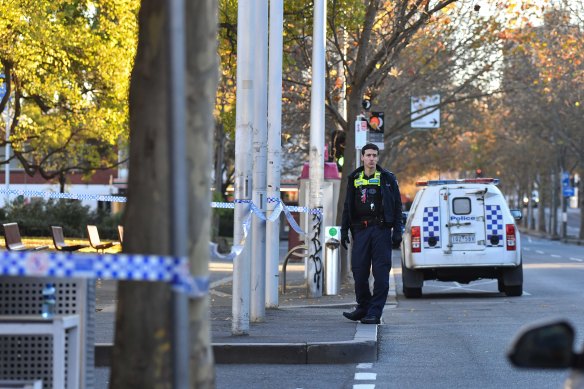
A man was wounded in an early morning drive-by shooting in May 2021 near the popular Carlton restaurant strip.Credit: Joe Armao
Then there’s the kind of crime that’s bad for business, and has been confronting the area since the pandemic: rip-offs, stabbings and petty crime making traders concerned.
“The council are doing a bit for the street, but not doing enough,” Donnini says.
“Melbourne has changed as a whole. It’s not just Carlton has changed. So I think, as I said before, Carlton being an extension, especially south Carlton being the extension of the north of the CBD, I think there’s a bit of a problem area there.”
Last year Carlton Inc – a Lygon precinct traders group – took the rare step of publicly asking the city for help amid rising crime. The Crime Statistics Agency reported an increase from 180 to 280 recorded incidents of crimes against the person per year since 2015. Last year there were 1958 property and deception offences, the highest in the last 10 years.
Ask traders why and responses are vague. There are reports of two nightclubs further along Lygon Street warring over drug territory.
History repeats
The skyline of Carlton, like most parts of Melbourne, is readying for change.
Among the carpet of historic terrace homes are looming public housing towers that have housed communities since the middle of the 20th century. Another fixture of the suburb that provided shelter and community to new migrants, the diaspora are now facing an existential crisis.
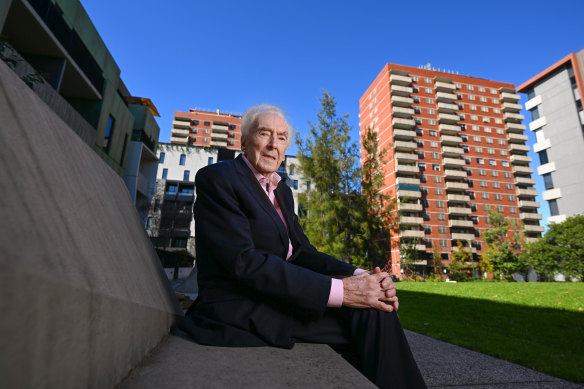
Architecture icon Peter McIntyre at the Carlton public housing flats he helped design in the 1960s.Credit: Joe Armao
At the corner of Nicholson and Elgin streets stand the empty red brick Housing Commission flats awaiting demolition and redevelopment, and wedged between Lygon and Rathdowne the remaining public housing towers are among 44 high-rises awaiting a similar fate over the next 30 years.
Just this week the government signed a contract with the company tasked with their demolition.
Among those unhappy about the demolition plan is revered modernist architect Peter McIntyre – now 97 – who in the 1960s helped design the red brick flats.
A series of reports commissioned by the Scanlon Foundation Research Institute found across the high-rise flats a thriving community of migrants, rich with the experience of starting new lives despite the challenges of intergenerational divides, tensions with authorities and the pervasive influence of the online world.
Age journalist Tony Wright observed that it was, perhaps, an experience not far removed from the children of Melbourne’s old slums, who had always had a ready-made community of friends on the mean streets.
In the 1930s the community united against the Housing Commission, a government department tasked with removing the slums, driving out poor residents.
Carlton is in a state of constant renewal. Who that renewal is for, though, is constantly changing.
Get the day’s breaking news, entertainment ideas and a long read to enjoy. Sign up to receive our Evening Edition newsletter here.